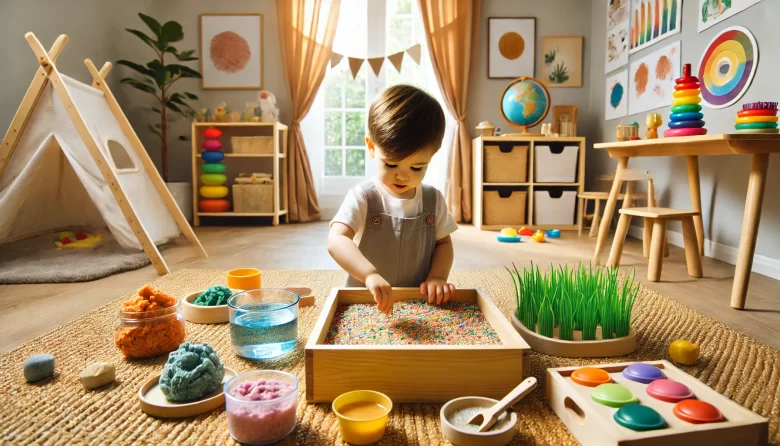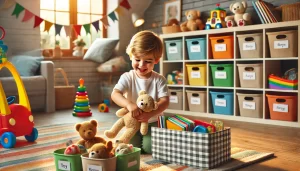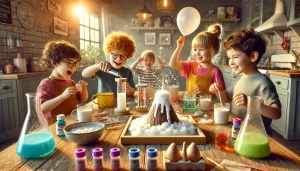Sensory play is a crucial part of early childhood development. It helps babies and young children explore the world, improve motor skills, and enhance cognitive abilities. Sensory activities engage the five senses—touch, sight, sound, smell, and taste—while making learning fun and interactive.
The best part? You don’t need expensive toys or fancy setups! Here are some simple and exciting sensory activities you can do at home using everyday materials.
Rice or Pasta Sensory Bin
Best for: Fine motor skills and tactile exploration
Materials Needed:
- A large plastic bin
- Uncooked rice or pasta
- Small toys, spoons, and cups
How to Play:
- Fill the bin with dry rice or pasta.
- Hide small toys inside and let your child dig them out.
- Give them cups and spoons to scoop and pour the rice.
This activity enhances touch sensitivity, improves hand-eye coordination, and encourages imaginative play.
Water Play with Floating Objects
Best for: Cause-and-effect learning and sensory exploration
Materials Needed:
- A shallow container or bathtub
- Floating objects (rubber ducks, sponges, bottle caps)
- Cups or small bowls
How to Play:
- Fill a container with water.
- Place floating objects inside and let your child explore.
- Show them how to scoop, pour, and splash the water.
This fun activity stimulates touch, sight, and movement while introducing basic science concepts like floating and sinking.
Homemade Playdough
Best for: Creativity and fine motor development
Materials Needed:
- 2 cups of flour
- 1 cup of salt
- 1 cup of warm water
- Food coloring (optional)
How to Play:
- Mix all ingredients to form a soft dough.
- Let your child squish, roll, and mold the playdough.
- Use cookie cutters or household items to create shapes.
Playing with dough strengthens hand muscles, enhances creativity, and provides a calming sensory experience.
Ice Cube Exploration
Best for: Temperature awareness and hand coordination
Materials Needed:
- Ice cubes (plain or with small objects frozen inside)
- A shallow container
- Warm water (optional)
How to Play:
- Place ice cubes in a container.
- Let your child touch and observe how the ice melts.
- Add warm water to speed up the melting process.
This activity introduces temperature differences and builds curiosity about science.
Sound Exploration with Homemade Instruments
Best for: Auditory learning and rhythm development
Materials Needed:
- Empty plastic bottles
- Rice or beans
- Wooden spoons or plastic containers
How to Play:
- Fill bottles with different amounts of rice or beans to create shakers.
- Let your child shake them and listen to the sounds.
- Use spoons to tap on containers and create rhythms.
This activity helps children distinguish different sounds and builds an early sense of rhythm.
Scent Exploration with Spices and Fruits
Best for: Smell recognition and sensory stimulation
Materials Needed:
- Different spices (cinnamon, vanilla, nutmeg)
- Cut fruits (orange, lemon, banana)
- Small cups or cotton balls
How to Play:
- Place a small amount of each scent on a cotton ball or in a cup.
- Let your child smell each one and guess what it is.
- Talk about how different scents remind us of foods or places.
This activity strengthens the sense of smell and introduces children to new sensory experiences.
Bubble Wrap Popping Game
Best for: Tactile stimulation and fine motor control
Materials Needed:
- Bubble wrap
How to Play:
- Lay out a piece of bubble wrap.
- Encourage your child to pop the bubbles using their fingers or feet.
- Turn it into a game by counting pops or making patterns.
Popping bubble wrap is satisfying and helps develop finger strength and coordination.
Texture Walk (Barefoot Exploration)
Best for: Touch awareness and gross motor skills
Materials Needed:
- Different textured materials (grass, carpet, sand, fabric)
How to Play:
- Place different textures on the floor.
- Let your child walk barefoot over them.
- Ask them to describe how each texture feels (soft, rough, smooth).
This activity enhances touch sensitivity and strengthens balance and coordination.
Finger Painting Fun
Best for: Creativity and sensory exploration
Materials Needed:
- Non-toxic paint
- Large sheets of paper
- Apron or old clothes
How to Play:
- Let your child dip their fingers in paint and create patterns.
- Encourage them to mix colors and explore different textures.
- Talk about how the paint feels—cool, wet, smooth.
Finger painting promotes self-expression and fine motor skill development.
Nature Sensory Collection
Best for: Outdoor learning and exploration
Materials Needed:
- Leaves, rocks, flowers, or sticks
- A basket or container
How to Play:
- Go outside and collect natural items.
- Let your child explore the textures, colors, and smells.
- Create a collage or a small nature display with their findings.
This activity encourages curiosity and appreciation for nature while providing a full sensory experience.
Final Thoughts
Sensory activities are an excellent way to help children learn through touch, sight, sound, smell, and movement. These simple, fun activities not only stimulate brain development but also provide a great bonding experience between you and your child.
Try incorporating these sensory play ideas into your daily routine and watch your little one explore the world with curiosity and excitement!




